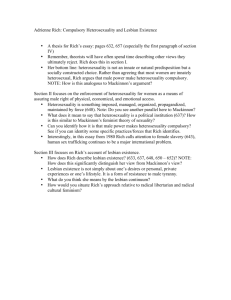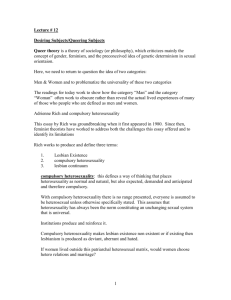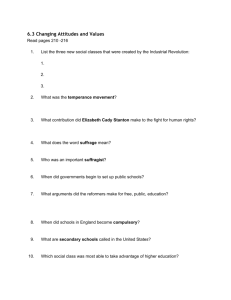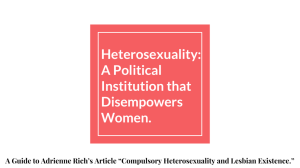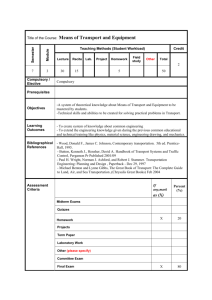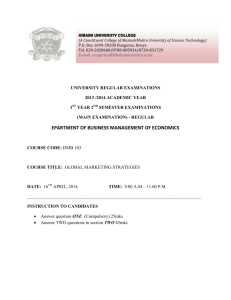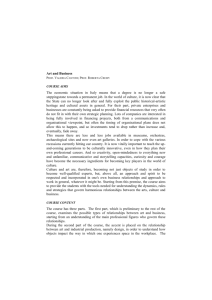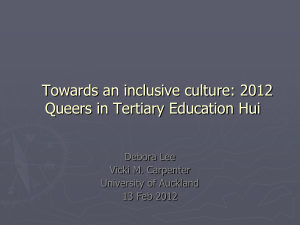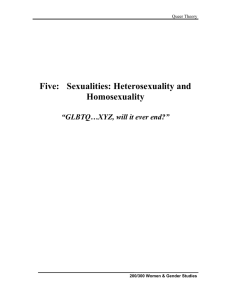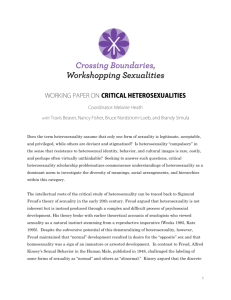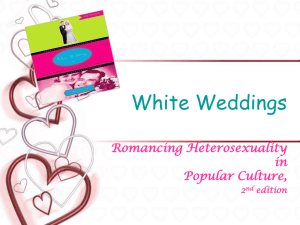Compulsory Able-Bodiedness and QueerlDisabled Existence
advertisement
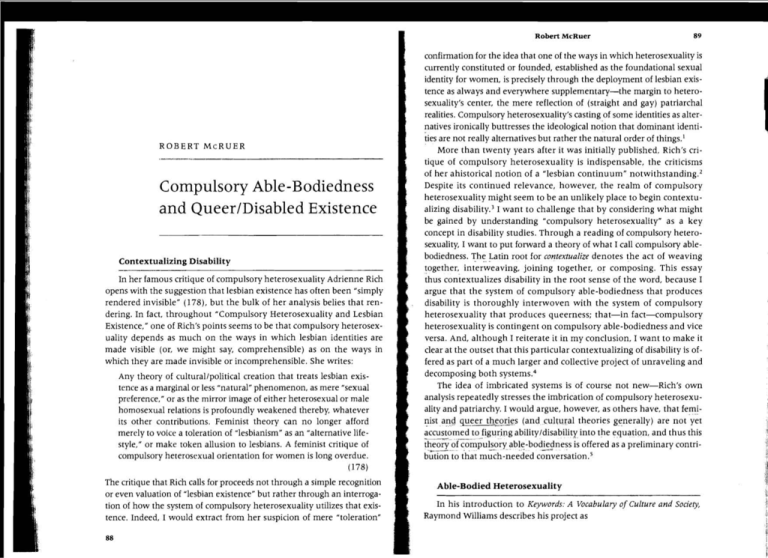
Robert McRuer ROBERT McRUER . Compulsory Able-Bodiedness and QueerlDisabled Existence Contextualizing Disability In her famous critique of compulsory heterosexuality Adrienne Rich opens with the suggestion that lesbian existence has often been "simply rendered invisible" (178), but the bulk of her analysis belies that rendering. In fact, throughout "Compulsory Heterosexuality and Lesbian Existence," one of Rich's points seems to be that compulsory heterosexuality depends as much on the ways in which lesbian identities are made visible (or, we might say, comprehensible) as on the ways in which they are made invisible or incomprehensible. She writes: Any theory of culturallpolitical creation that treats lesbian existence as a marginal or less "natural" phenomenon, as mere "sexual preference," or as the mirror image of either heterosexual or male homosexual relations is profoundly weakened thereby, whatever its other contributions. Feminist theory can no longer afford merely to voice a toleration of "lesbianism" as an "alternative lifestyle," or make token allusion to lesbians. A feminist critique of compulsory heterosexual orientation for women is long overdue. (178) The critique that Rich calls for proceeds not through a simple recognition or even valuation of "lesbian existence" but rather through an interrogation of how the system of compulsory heterosexuality utilizes that existence. Indeed, I would extract from her suspicion of mere "toleration" I I I I , li 89 confirmation for the idea that one of the ways in which heterosexuality is currently constituted or founded, established as the foundational sexual identity for women, is precisely through the deployment of lesbian existence as always and everywhere supplementary-the margin to heterosexuality's center, the mere reflection of (straight and gay) patriarchal realities. Compulsory heterosexuality's casting of some identities as alternatives ironically buttresses the ideological notion that dominant identities are not really alternatives but rather the natural order of things.' More than twenty years after it was initially published, Rich's critique of compulsory heterosexuality is indispensable, the criticisms of her ahistorical notion of a "lesbian continuum" notwithstanding2 Despite its continued relevance, however, the realm of compulsory heterosexuality might seem to be an unlikely place to begin contextualizing di~ability.~ I want to challenge that by considering what might be gained by understanding "compulsory heterosexuality" as a key concept in disability studies. Through a reading of compulsory heterosexuality, I want to put forward a theory of what I call compulsory ablebodiedness. The - .. Latin root for contextualize denotes the act of weaving together, interweaving, joining together, or composing. This essay thus contextualizes disability in the root sense of the word, because I argue that the system of compulsory able-bodiedness that produces disability is thoroughly interwoven with the system of compulsory heterosexuality that produces queerness; that-in fact-compulsory heterosexuality is contingent on compulsory able-bodiedness and vice versa. And, although I reiterate it in my conclusion, I want to make it clear at the outset that this particular contextualizing of disability is offered as part of a much larger and collective project of unraveling and decomposing both system^.^ The idea of imbricated systems is of course not new-Rich's own analysis repeatedly stresses the imbrication of compulsory heterosexuality and patriarchy. I would argue, however, as others have, that feminist and queer theories (and cultural theories generally) are not yet accustomed to figuring abilityldisability into the equation, and thus this -theory of compulsory able-bodiedness is offered as a preliminary contri--bution to that much-needed con~ersation.~ c - B I Able-Bodied Heterosexuality In his introduction to Keywords: A Vocabulary of Culture and Society, Raymond Williams describes his project as 90 COMPULSORY ABLE-BODIEDNESS Robert McRuer the record of an inquiry into a vocabulary: a shared body of words and meanings in our most general discussions, in English, of the practices and institutions which we group as culture and society. Every word which I have included has at some time, in the course of some argument, virtually forced itself on my attention because the problems of its meaning seemed to me inextricably bound up with the problems it was being used to discuss. (15) A critique _-_ _ of normalcy - - - has similarly been central to the disability - rights movement and to disability_>sudies,with-for example-Lennard Davis's overview and critique-of the historical emergence of normalcy (Enforcing 23-49) orkosgmarie ~ a r l a n d - ~ h o m s o nintroduction 's of the ---. c_on_ceqtofthe "nolmag" (Extraordin-ayyBodies 8-8). Such scholarly and activist work positions us to locate the problems of able-bodied identity, to see the problem of the meaning of able-bodiedness as bound up with identity IS the problems it is being used to discuss. Arguably, able-bodied - ---at this juncture even more naturalized than heterosexual identity. At the very least, many people not sympathetic to queer theory will concede that ways of being heterosexual are culturally produced and culturally variable, even if and even as they understand heterosexual identity itself to be entirely natural. The same cannot be said, on the whole, for able-bodied identity. An extreme example that nonetheless encapsulates currently hegemonic thought on ability and disability is a notorious Salon article attacking disability studies that appeared online in the summer of 1999. Nora Vincent writes, "It's hard to deny that something called normalcy exists. The human body is a machine, after all-one that has evolved functional parts: lungs for breathing, legs for walking, eyes for seeing, ears for hearing, a tongue for speaking and most crucially for all the academics concerned, a brain for thinking. This is science, not culture" ("Enabling").6In a nutshell, you either have an able body or you don't. Yet the desirefordefinitional clarity might unleash more problems - . than ---- it contains; if it's hard to deny that something called normalcy exists, it's even harder to pinpoint what that something is. The -__ OED defines _ __ able-bodied redundantly -and negatively as "having an able body, i.e. one free from physical disability,-and capable of the physical exertions required of it; in bodily health; robust." Able-bodiedness, in turn, is defhed vaguely as "soundness of bodily health; ability to work; rob-qstness." The parallel structure of the definitions of ability and sexuality is $;ire striking: first. to be able-bodied is to be "free fromphysical disability," just as to be heterosexual is to be "the opposite of homosexual." second, even though the language of "the normal relations" expected of human beings is not present in the definition of able-bodied, the sense of normal relations is, especially with the emphasis on work: being able--._ _ bodied means being capable of the normal physical exertions required in a particular system of labor. It is here, in fact, that both able-bodied identity and the Oxford Englrsh Dictionary betray their origins in the nineteenth Although Williams is not particularly concerned in ZCeywords with feminism or gay and lesbian liberation, the processes he describes should be recognizable to feminists and queer theorists, as well as to scholars and activists in other contemporary movements, such as African American studies or critical race theory. As these movements have developed, increasing numbers of words have indeed forced themselves on our attention, so that an inquiry into not just the marginalized identity but also the dominant identity has become necessary. The problem of the meaning of masculinity (or even maleness), of whiteness, of heterosexuality has increasingly been understood as inextricably bound up with the problems the term is being used to discuss. One need go no further than the Oxford English Dictionary to locate problems with the meaning of heterosexuality. In 1971 the OED Supplement defined heterosexual as "pertaining to or characterized by the normal relations of the sexes; opp. to homosexual." At this point, of course, a few decades of critical work by feminists and queer theorists have made it possible to acknowledge quite readily that heterosexual and homosexual are in fact not equal and opposite identities. Rather, the ongoing subordination of homosexuality (and bisexuality) to heterosexuality allows heterosexuality to be institutionalized as "the normal relations of the sexes," while the institutionalization of heterosexuality as the "normal relations of the sexes" allows homosexuality (and bisexuality) to be sub, ordinated. And, as queer theory continues to demonstrate, it is precisely the introduction of normalcy into the system that introduces compulsion. "Nearly everyone," Michael Warner writes in The Trouble with Normal: Sex, Politics, and the Ethics of Queer Life, "wants to be normal. And who can blame them, if the alternative is being abnormal, or deviant, or not being one of the rest of us? Put in those terms, there doesn't seem to be a choice at all. Especially in America where [being] normal probably outranks all other social aspirations" (53).Compulsion is here produced and covered over, with the appearance of choice (sexual preference) mystifying a system in which there actually is no choice. 2 91
